 Place: Central Park
Place: Central Park
Address: 410 Cumberland (Map)
Opened: 1894
Cost: $20,000 (original land purchase); $5.6m in renovations (2008-10)
Background:
As commercial development increased in the Exchange District, residential development was pushed further west. In the mid 1880s the land around what is now Central Park was opened up and a collection of middle class homes began to appear. (For a look at two of those homes).
As the city got a grip on the explosive growth of the 1880s, thought turned toward quality of life issues and in 1893 the first parks board was created.
Under Edward Drewery the board purchased land for four parks that year, (or "ornamented squares or breathing spaces" as they referred to them): Fort Rouge (on River Ave); St. John's (on Main St); Victoria (Waterfront Drive) and Central. (The Drewery brothers were also very active in the cycling and cycle path movement in the 1890s).
The land that is now Central Park was not yet developed. It was wet and boggy and would require a lot of work and fill to level off. The city purchased the land from the HBC for $20,000.
Circa 1897 (source)
Initially, the park was a natural space with grass, a few trees and gravel paths. After the turn of the century the trend was toward more active park spaces and by 1905 things like tennis courts, a band shell and more gardens were added by 1905.
Hoover and Town above, Benard's below
Once the park was established the land immediately surrounding it made way for upscale homes. One of the earliest was the Hoover and Town Duplex in 1901 (for pdf report). Even grander was the home purchased by French-Canadian hoteliers the Benards in 1903 (for pdf report).
Central Park and area ca. 1911 (source)
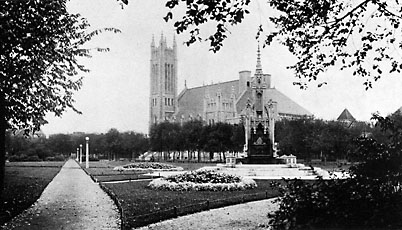 With increased population growth came more development in the area including Isbister School on Vaughan Street (1898) and the Warwick Apartments (1909).
With increased population growth came more development in the area including Isbister School on Vaughan Street (1898) and the Warwick Apartments (1909).
In 1914 the two iconic images of the Central Park neighbourhood came to be.
Knox Presbyterian Church had outgrown it's building on Fort. The congregation began construction on the new Knox in 1914, though the War intervened and the structure was not completed until 1917. Waddell Fountain, the monument to Emily Margaret Waddell, was built in 1914 adding a focal point to the park.
 With increased population growth came more development in the area including Isbister School on Vaughan Street (1898) and the Warwick Apartments (1909).
With increased population growth came more development in the area including Isbister School on Vaughan Street (1898) and the Warwick Apartments (1909).
In 1914 the two iconic images of the Central Park neighbourhood came to be.
Knox Presbyterian Church had outgrown it's building on Fort. The congregation began construction on the new Knox in 1914, though the War intervened and the structure was not completed until 1917. Waddell Fountain, the monument to Emily Margaret Waddell, was built in 1914 adding a focal point to the park.
Central Park Lodge ca. 1963 (source)
The Depression, then the flight to the suburbs in the post World War II period, saw a decline in the fortunes of the Central Park area. The large houses and grand apartment blocks were divided into smaller and smaller units. Eventually, many were knocked down to make way for a phenomenon of the 60s and 70s - the high rise housing development.
In the mid 1980s the area saw a huge change under the Core Area Initiative. To the south, blocks of retail were razed to make way for the nearby Portage Place Mall and Place Promenade apartment complexes. The streets surrounding Central Park had most of their remaining houses removed to make way for high-rises, social housing, a new elementary school and other developments.
Social issues around the park, however, had not changed. Central Park had become a hang out for the homeless and other marginalized people. It eventually gained the reputation as a park where drug and gang activity flourished.
The late nineties saw an influx of a new kind - African refugees and immigrants. As the population took root the community began to take increased interest in the park. In 2006 a weekend African Market sprang up. The pathways became entertainment places and the fields became soccer pitches.
After years of neglect the park needed rehabilitation to handle the increased use. The three levels of government pledged $5.6m, $1m of that from retired businessman Gerry Grey. Consultations with the community found that they wanted things like a soccer pitch with artificial turf, better play structures and a toboggan slide area. The project included a refurbishment of the Waddell Fountain.
Construction began in 2009 and in August 2010 the 'new' Central Park opened.
Though the neighbourhood around the park continues to have it's socioeconomic problems, it is hoped that the new feeling of ownership shown by residents, coupled with the renovations will allow Central Park once again be a place of beauty and pride in the downtown.
Related:
Winnipeg's early parks MB Historical Society
A look at the NEW Central Park WDP (includes links to media, reference and photos of the renovation project).



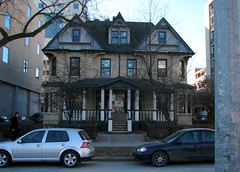
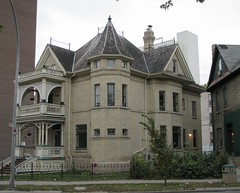



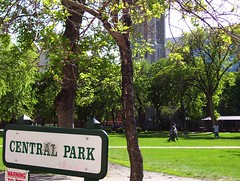
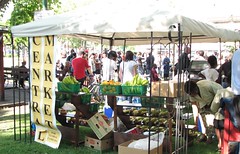
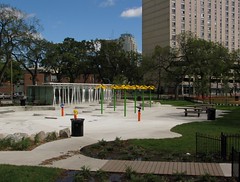
No comments:
Post a Comment